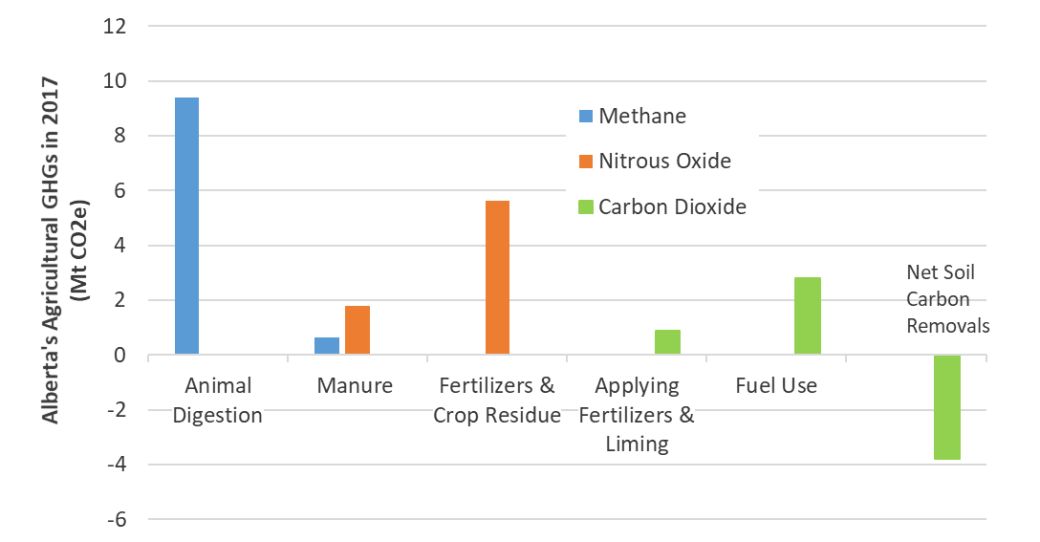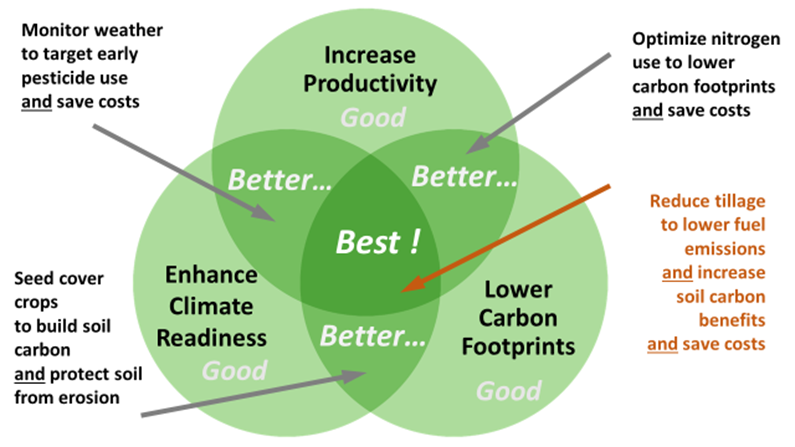Government mail service may be affected by the Canada Post labour disruption. Learn about how critical government mail will be handled.
Background
Climate smart agriculture is a term associated with management practices that lower greenhouse gases (GHGs). This in turn increases efficiency of resources and resilience to changing climates while supporting innovation and ensuring food security.
Climate change is the long-term shift in weather patterns, such as temperature, precipitation and timing of events. Climates can change gradually over wide areas, or rapidly with high intensity in specific locations.
Greenhouse gases in the atmosphere act as a thermostat that controls the earth’s climate. Increasing levels of GHGs in the atmosphere has been linked to:
- more variable temperatures, with trends towards more warmth
- more variable rainfall, with trends towards lower amounts
- extreme weather events that occur more often
These changes are influenced by human actions, including many industrial activities and the release of natural carbon sinks by cultivation and deforestation.
Types of agricultural GHGs
Agricultural operations influence 3 types of GHGs over a wide range of production practices:
Methane (CH4) comes from plant and animal materials that are decomposing without oxygen. Sources include the stomachs of ruminants, liquid manure storages and shallow waterbodies.
Nitrous oxide (N2O) occurs when nitrogen is used by living organisms where oxygen is limited, including fertilizers under wet conditions, liquid and stockpiled manures, decomposing crop residues and cultivated soils.
Carbon dioxide (CO2) is emitted from fossil fuel use and decaying organisms. Some sources are on-farm fuel and energy use, soils after cultivation, summerfallow, or land use change from perennial to annual crops. However, some agricultural management practices can also create carbon “sinks”. Growing plants removes carbon dioxide from the atmosphere, and store it in soils. As soil carbon increases, it provides many benefits including improved soil health and climate resilience.
Increases in soil carbon are enhanced by:
- conservation tillage (direct seeding, reduced tillage)
- continuous cropping instead of leaving fields fallow
- growing perennials after annual crops
- planting trees or windbreaks
Figure 1: The 3 types of GHGs in agricultural systems are methane (CH4), nitrous oxide (N2O) and carbon dioxide (CO2)

Source: Environment Canada
Carbon dioxide equivalent (CO2e) is a standard unit used to express the impact of each different GHG in terms of the amount of CO2 that would create the same amount of warming. Compared with CO2, CH4 has 25 times more global warming potential and N2O has 298 times more global warming potential.
Agricultural impacts
In 2017, 8% of Alberta’s total GHGs were from agricultural sources; about half were from livestock production and half from cropping operations. On-farm fuel use represented about 13% of Alberta’s agricultural GHGs.
Increases in soil carbon storage due to conservation cropping (direct seeding and reduced tillage) and land use changes removed about 18% of Alberta’s agricultural GHGs.
National GHG emissions are reported annually by sector and province in the National Inventory Report on Greenhouse Gas Sources and Sinks in Canada (2019).
Figure 2: Alberta’s agricultural GHG emissions and removals in 2017

Source: Environment Canada
Trends indicate that:
- Methane from animal production in Alberta has decreased since 2005, due to efficiency improvements and lower cattle numbers.
- Higher yielding crops that use more fertilizer and manure have increased N2O.
- More land area in annual crops has increased CO2 from fuel use.
- Rates of soil carbon storage in 2009 reported removing close to one-fifth of agricultural GHGs. However, this is decreasing as conservation cropping becomes more widely practiced and areas of perennial crops decline according to Environment Canada
- At current adoption rates of carbon sequestering agricultural practices in Canada, it is reported that soil carbon accumulation can continue for at least until 2040. After this period, the continuance of sound farming practices that conserve the soil will maintain this sink rather than increase it.
Adaptive agriculture
With changing climates, agriculture’s impact on GHGs and vulnerability to extreme weather is receiving increased attention.
Using advanced agricultural practices, farmers and ranchers in Alberta gain benefits from practices that support climate smart agriculture goals of increased productivity, lower carbon footprints and enhanced climate resilience.
For example, as illustrated below in Figure 3, using conservation tillage to increase soil carbon storage and lower fossil fuel use is ‘Good’. It also lowers costs of fuel and labour, which is ‘Better’, while improving moisture infiltration and nutrient cycling to increase the capacity of soils to adapt to variable climate conditions (Best).
Figure 3: Using adaptive agriculture management can increase productivity, enhance climate resilience and lower carbon footprints

Adoption of new technologies and practices in these areas are resulting in new environmental market opportunities. In addition to gains in efficiency and climate resiliency associated with lowering GHGs, programs are available to help with improvements. For more information on possible programs, see Sustainable Canadian Agricultural Partnership.
Are there new ways that you can gain these benefits on your farm?
Opportunities for agriculture
Unlike most other sectors, agriculture can do more than just reduce GHGs. Agricultural management can also remove and store (sequester) GHGs as soil carbon, and/or replace fossil fuels with a range of bio-based renewable energy sources.
Figure 4: Agricultural GHG management

This range of opportunities to lower GHGs also offers benefits of improved production efficiencies, cost savings and adaptation to changing climates. Expanded use of proven management strategies will help farmers and ranchers respond to consumers’ expectations, remain competitive and capture emerging market opportunities.
The Development of a Farm-Level Greenhouse Gas Assessment Report summarizes the state of knowledge of agricultural GHG research in Alberta. This information laid the foundation for the Agricultural GHG Science Plan, which prioritizes research in the areas of soils, crops, livestock, land-use, energy and whole farm systems.
Farmers and ranchers can benefit from continuing to meet the challenges of a low-carbon economy and adapt to changing climates as outlined in the following climate smart agriculture sections:
Contact 310-FARM
Hours: 8:15 am to 4:30 pm (open Monday to Friday, closed statutory holidays)
Toll free: 310-FARM (3276) (in Alberta)
Phone: 403-742-7901 (outside Alberta)
Email: [email protected]